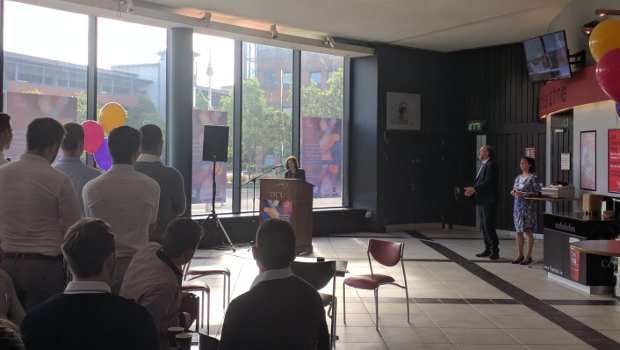The Dublin City University faculty of Engineering and Computing final year project exposition 2017 saw a huge breadth and depth in projects, from very low frequency radio observation to blockchain voting and advanced human interface devices for flight control.
In its thirtieth year, the expo attracts a broad range of attendees from industry, with support from SAP, IBM, FINEOS, Openet and Fidelity, all looking out for new talent and promising candidates for future careers.
“At its core, our faculty’s focus is to release the potential which our students have, to have impact,” said Prof Lisa Looney, dean, faculty of Engineering and Computing. “We believe that the range of Final Year Projects on display here today reflects the great opportunities for these young graduates to contribute to the advancement of Irish society over coming years. Many of the projects displayed represent products with immediate commercial potential; all demonstrate ingenuity, skill and technical capability of the highest calibre.”
Strong relationship
“DCU is well-known for its strong relationship with enterprise, innovation and entrepreneurship. We are confident that the students you meet here today will go on to have a strong impact on the various industries and sectors that you represent,” said Prof Looney.
The expo was opened by Aisling Mulholland of SAP Ireland, an alumnus of university and an erstwhile presenter at a previous expo.
Scholarships were also announced, with Urban Volt providing a masters for business or engineering, and Intel providing 16 scholarship places with a yearly funding of €3,000 under its memorandum of understanding with DCU.
But it was the students who were the stars with the huge range and variety of projects.
Neural network
Eoin Magner used a convolutional neural network, with Python and TensorFlow, to colourise black and white images. By using colour images to examine how they are turned to greyscale, the network learned the reverse process to perfect the technique.
CoderDojo has been a worldwide success, but handling that success has become difficult, as the dojo management system creaked under the load. Cian Butler developed a containerised microservice architecture to allow the system to scale as necessary, with greater resilience.
While the high frequency radio behind the likes of 5G is getting all the attention at the moment, as evidenced by project of Sean Moran looking at fibre-supported 5G, very low frequency (VLF) radio was the focus for Fady Makram Max Abdelmalek.
Abdelmalek designed a radio receiver to monitor the ionosphere for evidence of disruption that can provide early warning for the likes of natural disasters, and manmade ones, that could disrupt wireless communications or GPS.
Human interface
Lukasz Markowski used field programmable gate arrays (FPGA) for a low cost method to overlay video on displays that could be used in aviation. Markowski said that the technology could be used to take feeds from cameras on the external surfaces of an aircraft to augment the information available for pilots and could be integrated with instruments, such as a head up display.
Perhaps one of the most interesting projects from an IT pro perspective was the use of blockchain technology in voting systems. Michael Wall developed a proof of concept electronic voting system that implements a blockchain database and cryptography to provide anonymity, tamper free ballots and ease of tallying in voting. Using the Go development language, Wall said the system was naturally highly resistant to tampering and interference, providing a resilient system that protects the identity and integrity of voters.
TechCentral Reporters








Subscribers 0
Fans 0
Followers 0
Followers